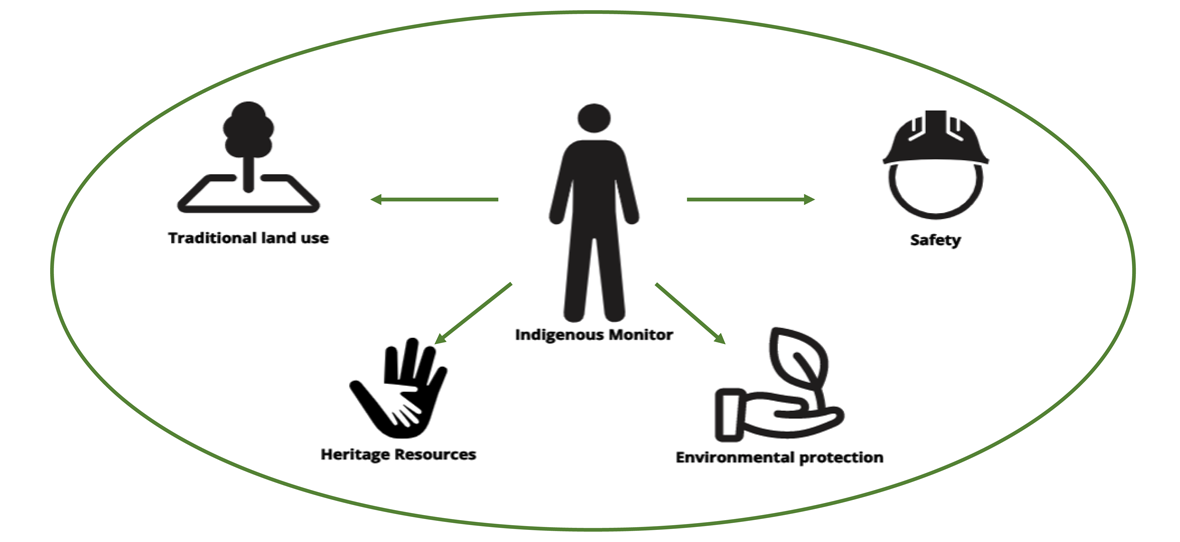The CER’s Indigenous Monitoring Program for Keystone XL (KXL IM Program)
The CER believes involving Indigenous Peoples in our work improves regulatory outcomes for all Canadians. In 2019, the CER launched an Indigenous Monitoring Program for the Keystone XL Project. Trained Indigenous monitors have supported the CER’s inspection and monitoring activities for the Keystone XL construction work in Alberta in 2020. These activities include things like field inspections which look at safety management and environmental protection, among others. Involving Indigenous monitors has enhanced the CER’s awareness and understanding of the diversity of Indigenous traditional and cultural worldviews, including specific expertise in traditional land use, sacred sites and historical knowledge.
Building on the IAMC monitoring programs
The Keystone XL Project was not included in the federal government’s Indigenous Advisory and Monitoring Committee (IAMC) initiative, which included the Trans Mountain Expansion (TMX) Project and Enbridge Line 3 Project. However, Nations in the area of the Keystone XL Project requested a similar monitoring program be developed for the Keystone Project. The CER did not have the authority or funding to establish an IAMC for the Project, but given its vision to involve Indigenous peoples in the CER’s work it agreed to fund an Indigenous Monitoring Program for the construction phase of the Project. Best practices and lessons learned from the TMX and Line 3 monitoring programs were applied during monitoring activities for the Keystone XL Project.
The KXL IM Program Framework
In May 2019, the CER launched a public tender process open to any Indigenous business interested in providing Indigenous monitoring services, including engaging with and hiring monitors from affected Indigenous Nations. In August 2019, two contracts were signed: one with X-Terra Environmental Services Ltd (majority owned by Thunderchild First Nation); and one with Apeiron Resources Ltd (owned by citizens of the Métis Nation of Alberta Region 3, and partnering with Canada North Environmental Services).
The following Nations were represented in the KXL Indigenous Monitoring Program:
- Thunderchild First Nation (Treaty 6) (Contractor & Indigenous Monitor)
- Carry The Kettle Nakoda First Nation (Treaty 4), (Indigenous Monitor & advisor)
- Pheasant Rump First Nation (Treaty 6) (advisor)
- Métis Nation of Alberta – Region 3 (Contractor & Indigenous Monitor)
- Métis Nation of Saskatchewan – Region 3 (Indigenous Monitor & advisor).
Additionally, CER staff engaged with several Indigenous nations, and assisted the Contractors and Indigenous Monitors to engage with Indigenous nations communities. The purpose of the engagement being to collect information such as local knowledge to inform inspections, and to establish connections between the Indigenous Monitors and Elders or Knowledge Keepers.
Indigenous Monitor Training
Indigenous Monitors, CER inspection officers, and others participated in a four-day training program. These sessions provided an opportunity for the Monitors and inspection officers to share information and learn from each other. In addition to the CER’s regulatory training sessions, the Contractors provided onboarding training to their IMs, and the IMs were required to complete safety training courses.
Indigenous Monitors on the Inspection Team
Indigenous Monitor(s) worked as a team with CER Inspection Officers before, during and after the inspections, enhancing the expertise of the inspection team. Involving Indigenous monitors enhanced the ability of CER’s staff to gain awareness and understanding of the diversity of Indigenous traditional and cultural worldviews, including specific expertise in traditional land use, sacred sites and historical knowledge. The role of the Indigenous Monitors included:
- helping with scoping for the inspections
- accompanying the inspection officers during the inspections
- providing observations to be included in the CER’s inspection report.

Compliance Verification Activities (e.g. inspections) and Reports
Five inspections were completed for the Keystone XL construction in Alberta between August 2020 and February 2021, prior to the US permit being rescinded. The CER and IMs also reviewed KXL’s COVID risk mitigation plans and participated in an information exchange meeting with TC Energy regarding the Indigenous Monitoring programs. The inspection reports can be found here: CER Inspection Reports. The CER’s inspection reports include the IMs’ observations.
Contact Us
E-mail: KeystoneXL-Info@cer-rec.gc.ca
Telephone (toll free): 1-800-899-1265
Fax: 403-292-5503
Toll free fax: 1-877-288-8803
Media Inquiries
Erin Dottor
Communications Officer
Email: erin.dottor@cer-rec.gc.ca
Telephone: 403-629-2732
Media Relations
E-mail: media@cer-rec.gc.ca
TransCanada Keystone Contact Information
Telephone: 1-866-717-7473
Email: Keystone@transcanada.com
Keystone XL website
- Date modified:
